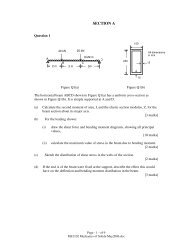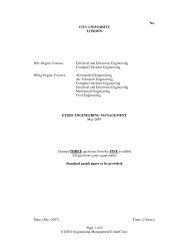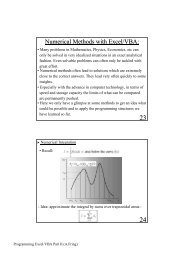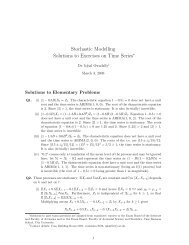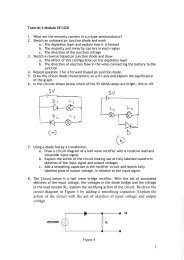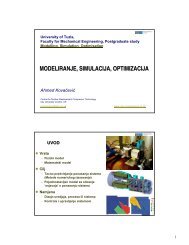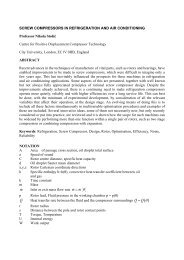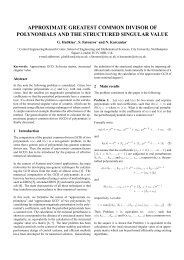The Design of a Family of Screw Compressors for Oil–Flooded ...
The Design of a Family of Screw Compressors for Oil–Flooded ...
The Design of a Family of Screw Compressors for Oil–Flooded ...
Create successful ePaper yourself
Turn your PDF publications into a flip-book with our unique Google optimized e-Paper software.
<strong>The</strong> measurements were taken by transducers and both recorded and processed in a<br />
computerized data logger <strong>for</strong> real time presentation. A screen record <strong>of</strong> the compressor<br />
measurement is given in Fig. 4. A Diesel engine prime mover <strong>of</strong> 100 kW maximum output,<br />
which may operate at variable speed, was used as a prime mover. This enabled the testing <strong>of</strong> oilflooded<br />
screw compressors with discharge rates <strong>of</strong> up to 16 m 3 /min.<br />
At the time <strong>of</strong> writing <strong>of</strong> this paper, three compressor sizes had been produced and tested.<br />
Measured values were used to calculate compressor flow, power and specific power and the oil<br />
injection rate was estimated by means <strong>of</strong> a heat balance. Both the predicted and measured test<br />
results <strong>of</strong> three compressor sizes, namely the 4/5-73 mm, 4/5-102 and 4/5-159 mm units are<br />
presented in Figs 5, 6 and 7 in the <strong>for</strong>m <strong>of</strong> compressor flow as a function <strong>of</strong> input power. As may<br />
be observed, the correlation between the estimated and measured values is good and it may be<br />
concluded from the plot <strong>of</strong> specific power, given in Fig 2 that the compressor efficiency is higher<br />
than in majority <strong>of</strong> commercially available compressors.<br />
<strong>The</strong> experimentally derived compressor per<strong>for</strong>mance data has been compared with results taken<br />
from brochures issued by all well known manufactures <strong>of</strong> equivalent machines. It should be<br />
noted that there are wide variations between machines and it is normal practice to base such<br />
publications on the best results. Despite this, no published results could be found with better<br />
per<strong>for</strong>mance than that recorded in this paper.<br />
5 CONCLUSION<br />
<strong>The</strong> execution <strong>of</strong> the development <strong>of</strong> the compressor family described in this paper has been<br />
used as an opportunity to publicise the advantages <strong>of</strong> advanced simulation models and<br />
modern rotor pr<strong>of</strong>iling techniques to determine the optimum rotor pr<strong>of</strong>ile, size and speed, the<br />
volume ratio and the shape and position <strong>of</strong> the suction and discharge and oil port. <strong>The</strong>se have<br />
been made easy to incorporate into the design by the ability to transfer the output data thus<br />
derived directly in a CAD system. However, it should be noted that, apart from the<br />
improvements made due to the superior rotor pr<strong>of</strong>ile and computer optimisation, attention was<br />
paid to every detail <strong>of</strong> the designs such as the ports, the oil injection system and the bearings<br />
in order to derive the full benefit possible from this approach. <strong>The</strong> high efficiencies obtained<br />
on test, as well as the reduced size and weight <strong>of</strong> these machines, compared to the models which<br />
they have been designed to replace, all confirm the validity <strong>of</strong> this approach.<br />
REFERENCES<br />
1 Sakun I.A, 1960: Vintovie kompresorii, (screw <strong>Compressors</strong>) Mashinostroenie Leningrad<br />
2 Amosov P.E, Bobrikov, N.I, Schwartz A.I, Vernii A.L, 1977: Vintovie kompresornie mashinii - Spravochnik,<br />
(Handbook <strong>of</strong> <strong>Screw</strong> Comp ressor Machines) Mashinstroienie, Leningrad<br />
3 Rinder L, 1979: Schraubenverdichter (<strong>Screw</strong> <strong>Compressors</strong>), Springer Verlag, New York<br />
4 O'Neill P.A, 1993: Industrial <strong>Compressors</strong>, <strong>The</strong>ory and Equipment, Butterworth-Heinemann, Ox<strong>for</strong>d<br />
5 Arbon A, 1994: Twin Shaft <strong>Compressors</strong> in Gas Process Industry, IMechE Publications London<br />
6 Xing Z. W, 2000: <strong>Screw</strong> <strong>Compressors</strong>, Machine Press, Beijing<br />
7 Stosic N, Hanjalic K, 1997: Development and Optimization <strong>of</strong> <strong>Screw</strong> Machines with a Simulation Model, Part<br />
I: Pr<strong>of</strong>ile Generation, ASME Transactions, Journal <strong>of</strong> Fluids Engineering, Vol 119, p 654<br />
8 Hanjalic K, Stosic N, 1997: Development and Optimization <strong>of</strong> <strong>Screw</strong> Machines with a Simulation Model, Part<br />
II: <strong>The</strong>rmodynamic Per<strong>for</strong>mance Simulation and <strong>Design</strong> Optimization, ASME Transactions, Journal <strong>of</strong> Fluids<br />
Engineering, Vol 119, p 659<br />
9 Stosic N, Smith I. K, Kovacevic A, Aldis C. A, 1997: <strong>The</strong> <strong>Design</strong> <strong>of</strong> a Twin-screw Compressor Based on a New<br />
Pr<strong>of</strong>ile, Journal <strong>of</strong> Engineering <strong>Design</strong>, Vol 8, 389




